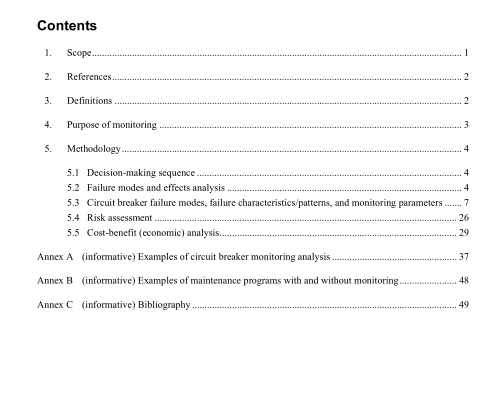IEEE C37.10.1-2000 pdf download.IEEE Guide for the Selection of Monitoring for Circuit Breakers
5. Methodology
Several methodologies are introduced to assist a user with arriving at a monitoring selection based on the greatest reduction in failure rate, considering the risks of such failure and the cost benefit value introduced by the application of monitoring.
A methodology termed FMEA is presented to assist identification of significant failure modes and their causes. The concepts of risk assessment are then introduced. The subsequently derived priority and eco- nomic analysis then determines when and where monitoring is warranted.
5.1 Decision-making sequence The process described in this guide is as follows. Stage 1:
a) Undertake an FMEA analysis to identify failure modes, causes of the failure modes, and causes of failure characteristics for the specific family of circuit breakers. This also indicates the most appro- priate monitoring options.
b) The FMEA identifies monitoring options that are available and appropriate to observe the condition of circuit breakers. This stage is described in the succeeding section and given in Table 2 through Table 19. The process for Stage 1(a) and Stage 1(b) would be to identify those elements in Table 2 through Table 19 that are important for the circuit breaker group in the analysis. A column is pro- vided for adding the score from Stage 2(a) to Table 2 through Table 19. Stage 2:
a) Apply a risk assessment for the specific circuit breaker application. Conduct a risk assessment to quantify the risk associated with each specific circuit breaker failure mode (i.e., deterioration in functional capability or failure to functionally perform). This may indicate that monitoring should be applied almost regardless of cost. Typically, the risk assessment outcome will be used in conjunction with cost-benefit analysis. A risk matrix, as shown in Table 20, Table 21, Table 22, and Table 23, should be completed.
b) Undertake the cost-benefit analysis as indicated in the last section and in Table 7. Annex A provides two specific examples.
Stage 3: The decision to implement continuous or periodic monitoring may be unambiguously indicated from either risk assessment or cost-benefit analysis alone. In other cases, a balanced judgment may be more appropriate. The process is described in the flow diagram of Figure 1.
5.2 Failure modes and effects analysis FMEA or FMECA are methods of reliability analysis intended to identify failures that have significant con- sequences affecting the system performance in the considered application. See IEC 60812:1985-07. The term failure, when used in the context of this guide and its companion standard IEEE Std C37.10- 1995, is used to mean the “unsuccessful performance of function” regardless of cause, component, or device involved. Failure to perform the intended function(s) need not imply that the particular component failed, but that the component or system function was not satisfied. Functional failures are not necessarily caused by circuit breaker or component failure. External causes, including misapplication, should also be considered.
“The FMEA is based on that defined component or subassembly level where the basic failure criteria (primary failure modes) are available. Starting from the basic element failure characteristics and the func- tional system structure, the FMEA determines the relationship between the element failures and the system failures, malfunctions, operational constraints, and degradation of performance or integrity. To evaluate secondary and higher order system and subsystem failures, the sequences of events in time may also have to be considered” (IEC 60812:1985-07). Users of this guide are encouraged to make use of CEA Project No. 485T1049 (1997), Bierer et al. [B6], CIGRE [B5], and IEEE 100 [B12].
An FMEA is used to develop an understanding of what can fail, its effect on the functional system, and what characteristic can be monitored to observe the condition of a circuit breaker (or other devices).
This analysis derives the greatest value from being performed on a system basis rather than on a component basis. In this discussion, a power circuit breaker is considered a system. The circuit breaker becomes a com- ponent when applied in an electric power grid (system).IEEE C37.10.1 pdf download.IEEE C37.10.1-2000 pdf download
IEEE C37.10.1-2000 pdf download

Leave a Reply